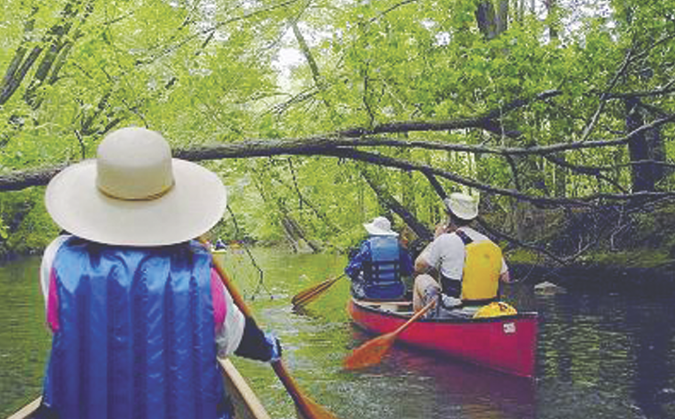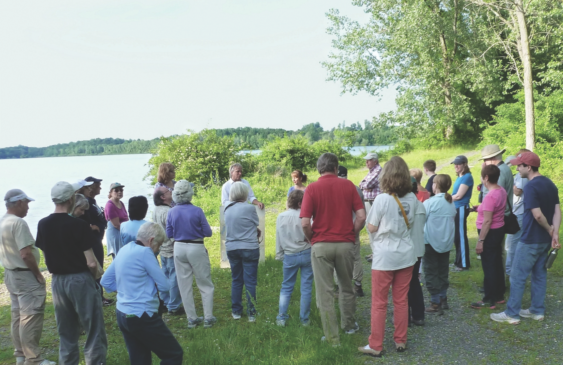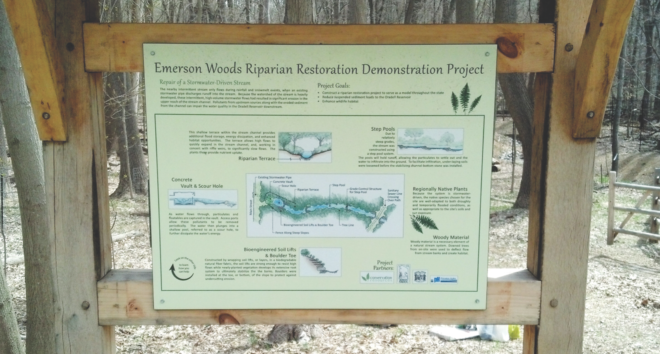
[slideshow_deploy id=’899′]
BY HILLARY VIDERS
SPECIAL TO THEPRESSGROUP.NET
BERGEN COUNTY, N.J.—Since 1988, the nonprofit Bergen SWAN (Bergen Save the Watershed Action Network) has been focusing on conservation, education, advocacy, and litigation in a difficult environment—the fully developed suburban communities surrounding the Hackensack River watershed.
Besides its legal forays, Bergen SWAN hosts numerous public outreach events in local communities, including walkathons, benefit concerts, lectures, nature walks, and workshops. On Sept. 23, Bergen SWAN invites you to an exciting Story Night at Hague Park in Oradell on the banks of the Hackensack River, a breathtakingly beautiful site. The evening will take place under tents lit by lanterns and will include music, dancers and presentations by nature and historic preservation experts.
The audience will also be invited to tell their stories of “life lived along freshwater waterways—creeks, brooks, rills, streams, drainages, vernal pools, ponds, swamps, lakes, and reservoirs.”
Attendees will also have the opportunity to go on a easy guided walk toward the river.
In addition to this being a fun night, it calls out an important fact: The Hackensack River watershed is an extremely valuable resource. Among other things, it is a critical drinking water source.
Lori Charkey, director of Bergen SWAN, told Pascack Press that after her 30 years protecting this resource, she remains as passionate as ever about conservation.
“If you live here, you are what you drink, and you drink what you contribute to your environment. We all need to work cooperatively toward a healthy watershed. It is especially important that those who live along our local streams take their role as caretaker seriously,” she said.
A watershed of many contrasts
The Hackensack River runs south from New City, New York, to the Newark Bay, surrounded by its 197-square-mile watershed basin. It is a river and watershed of many contrasts—32 percent is in New York State and 58 percent is in New Jersey—the upper portion is freshwater, the lower is estuary. The river faces many challenges from society, with 75 percent of 9,650 acres of wetlands urbanized.
Bergen SWAN was formed three decades ago by Green Party members and environmentally attuned students and residents of the Pascack Valley in response to the degradation of the watershed, which began decades ago. Their multi-pronged approach to preserving this priceless environment includes lobbying for better laws, ordinances, and policies to protect water quality and buffer forests.
The organization also works to educate the public to develop a sense of stewardship of the area’s woodlands, wetlands, and waterways.
Bergen SWAN concentrates its educational and preservation efforts specifically on the forested areas bordering the Hackensack River, its reservoirs, and feeder streams in the Northern and Pascack valleys. Unlike the southern, industrialized Hackensack, this section of the river is marked by unspoiled, mature forests containing towering canopies of evergreens, huge 20-inch round cottonwood trees, 100-year-old beeches, and woodland swamps.
Like the lower portion of the river, the Upper Watershed supports high quality wetlands and crucial wildlife habitat. The forested buffers which surround and protect our waterways fulfill a vital ecological function for human residents as well. Whereas many highly urbanized areas of the country obtain their water supply from a protected watershed outside of the developed region, Bergen County’s nearly one million inhabitants live and work within the watershed on which they depend for their water supply.
According to Charkey, the fully developed suburban communities routinely encroach on the wetland buffers surrounding Woodcliff Lake, Oradell Reservoir and Lake Tappan, which (along with Lake DeForest in Congers, N.Y.) comprise the Hackensack River watershed controlled by Suez that provides drinking water to over 1 million people in Bergen and Hudson counties.

Taking action
Bergen SWAN’s efforts to bring attention to the negative consequences of developing watershed buffer lands has attracted attention from thousands of residents, political representatives and candidates, the news media, fellow environmentalists, and the Environmental Defense Fund.
In Bergen SWAN’s first year of operation, they lobbied for and achieved passage of the Watershed Protection Act of 1988, a NJ law that is still in place and actively upheld.
Since then, Bergen SWAN has worked with several environmental organizations and agencies, such as the Environmental Defense Fund, Rutgers Environmental Law Clinic and Hackensack Riverkeeper. In 1993, they waged and won two legal cases against what was formerly United Water (now Suez). The first lawsuit resulted in a landmark settlement in 1993 that preserved over 700 acres of open space and put permanent protections on the land.
In the late 1990s, they undertook a second legal complaint against the water company. The case, settled in 2009, put protective easements on over 3,100 acres of SUEZ-owned watershed buffer lands. It also required the water company to set aside a $1 million Green Acres fund for the future purchase of additional protective open space by municipalities or land trusts.
Bergen SWAN was also an active player in the Bergen Open Space Coalition (BOSCO) which lobbied then-County Executive Pat Schuber to create a stable source of funding for purchase of conservation lands and other publicly beneficial properties and projects.
In 2002, Bergen SWAN worked with its environmental colleagues to successfully lobby then Governor James McGreevy to place stringent Category 1 Clean Water Act protections on the Hackensack River, its tributaries and reservoirs.

It’s work that matters, and you can help. According to Bergen SWAN, here are some things that people can do to help preserve the environment:
- Stop using toxic, persistent herbicides, fungicides, and pesticides on your lawn, trees, and gardens.
- Plant more native plants, especially those friendly to pollinators and birds.
- Take away as much lawn as you can, displacing it with other, more absorbent types of plantings.
- If you do have a lawn, mow it high and leave the clippings on the lawn using a mulcher attachment.
- Conserve water by planting xeriscape plants—water all your vegetation only in the morning or at don’t leave watering to a mindless timer that does not know when it is raining.
- Make sure that your down spouts drain into vegetated areas instead of onto paved surfaces. Better yet, plant at least one rain garden.
- Leave the leaves; try to manicure less. Dried leaves and stalks are a ticket to existence for caterpillars of endangered butterflies and moths.
- Don’t dump or litter, even if you think the material is biodegradable.
- Keep storm drains near your property free of litter and debris.
- Don’t feed the deer and other wildlife human food.
Note: Bergen SWAN welcomes volunteers, sponsors, and attendees for this star-filled Story Night on Sept. 23. Contact Lori Charkey at bergenswan@sprynet.com or (201) 666-1877.
[slideshow_deploy id=’899′]
